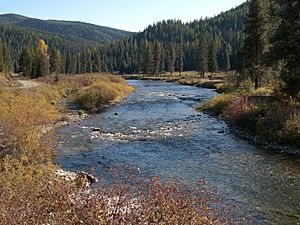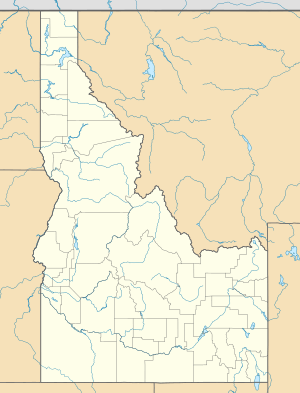Saint Joe River facts for kids
Quick facts for kids Saint Joe River |
|
|---|---|

Saint Joe River in the St. Joe National Forest
|
|
|
Location of the mouth of the Saint Joe River in Idaho
|
|
| Country | United States |
| State | Idaho |
| Counties | Shoshone County, Benewah County, Kootenai County |
| Physical characteristics | |
| Main source | Northern Bitterroot Range southwest of Superior, Montana, Shoshone County, Idaho 6,487 ft (1,977 m) 47°01′07″N 115°04′58″W / 47.01861°N 115.08278°W |
| River mouth | Coeur d'Alene Lake north of Heyburn State Park, Kootenai County, Idaho 2,129 ft (649 m) 47°23′35″N 116°45′15″W / 47.39306°N 116.75417°W |
| Length | 140 mi (230 km) |
| Basin features | |
| Basin size | 1,850 sq mi (4,800 km2) |
| Tributaries |
|
| Type: | Wild, Recreational |
| Designated: | November 10, 1978 |
The Saint Joe River (also called the St. Joe River) is a long river in northern Idaho. It flows for about 140 miles (225 km). This river is a tributary, which means it flows into a larger body of water. The Saint Joe River flows into Lake Coeur d'Alene.
The river starts high up in the Bitterroot Mountains. Its source is in eastern Shoshone County, at an elevation of about 6,487 feet (1,977 meters). From there, it flows west through the Saint Joe River Valley. It passes by the towns of Avery and Calder.
After Calder, the river enters Benewah County. It then flows through the town of St. Maries. Here, it meets its biggest branch, the Saint Maries River. The Saint Joe River then turns northwest. It goes through Heyburn State Park before reaching its end at Lake Coeur d'Alene.
Part of the river in Heyburn State Park is often flooded. This is because a dam built by Washington Water Power at Post Falls raises the water level. The Saint Joe River's mouth is at an elevation of about 2,129 feet (649 meters). Some people say it's the highest river in the world that boats can travel on. However, there are other rivers in Canada that are even higher and also navigable.
Contents
Protecting the Saint Joe River
In 1978, a large part of the Saint Joe River became protected. About 66.3 miles (106.7 km) of the river are now part of the National Wild and Scenic Rivers System. This system helps keep rivers natural and beautiful.
- About 26.6 miles (42.8 km) of the river are called "wild." This means they are kept very natural, with no dams or buildings.
- Another 39.7 miles (63.9 km) are called "recreational." These parts are also protected but allow for more activities like boating and fishing.
River Basin and Land
The Saint Joe River collects water from a large area. This area is called its watershed. It covers about 1,850 square miles (4,791 square kilometers) in the Idaho Panhandle. This watershed is part of the larger Spokane River watershed. The Spokane River then flows into the huge Columbia River basin.
Most of the land around the Saint Joe River is owned by the United States Forest Service. This land is part of the St. Joe National Forest. Other parts are owned by the Bureau of Land Management or the State of Idaho. Some land is privately owned.
Plants and Trees
The area around the Saint Joe River is mostly covered by mixed coniferous forest. This type of forest has different kinds of cone-bearing trees.
- Common trees include Douglas fir, true fir, larch, and pine.
- Near the river in high places, you'll find Alder trees.
- In lower areas, cottonwood trees are common near the river. Many of these lower areas have been turned into agricultural land for farming.
- In the river's floodplains (flat areas that can flood), you can see rushes, sedges, and cattails. These floodplains are also used to grow wild rice.
Amazing River Animals
The Saint Joe River is home to many different kinds of fish.
- Native fish include westslope cutthroat trout, mountain whitefish, and cedar sculpin.
- You can also find non-native fish like rainbow trout and brook trout.
- Chinook salmon and Kokanee salmon also live here.
The upper part of the Saint Joe River is very important for bull trout. It has the last group of these special fish in the Coeur d'Alene Lake watershed that can keep their population going on their own. Bull trout are considered a vulnerable species, meaning they need protection to survive.
See also
 In Spanish: Río Saint Joe para niños
In Spanish: Río Saint Joe para niños




